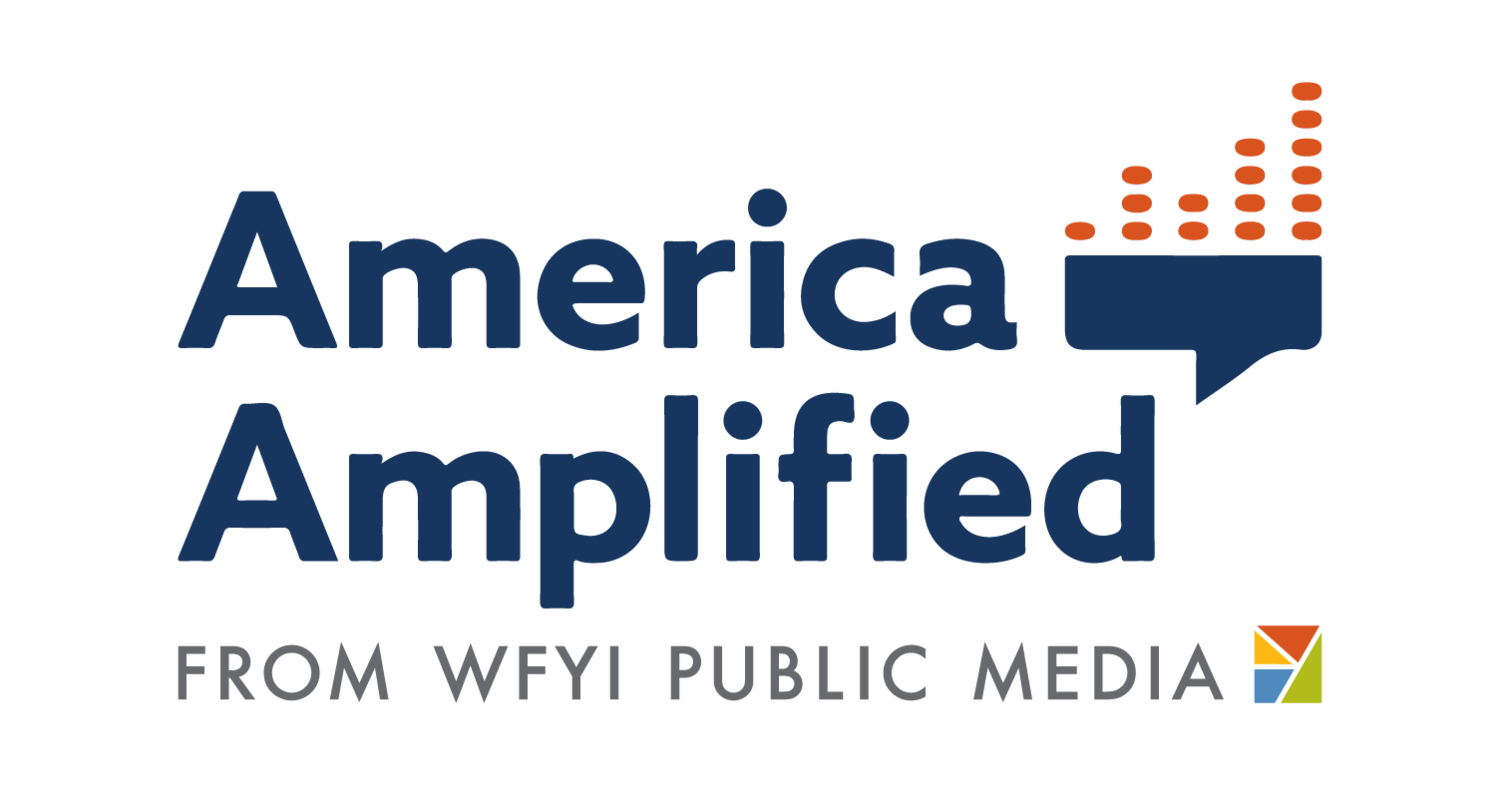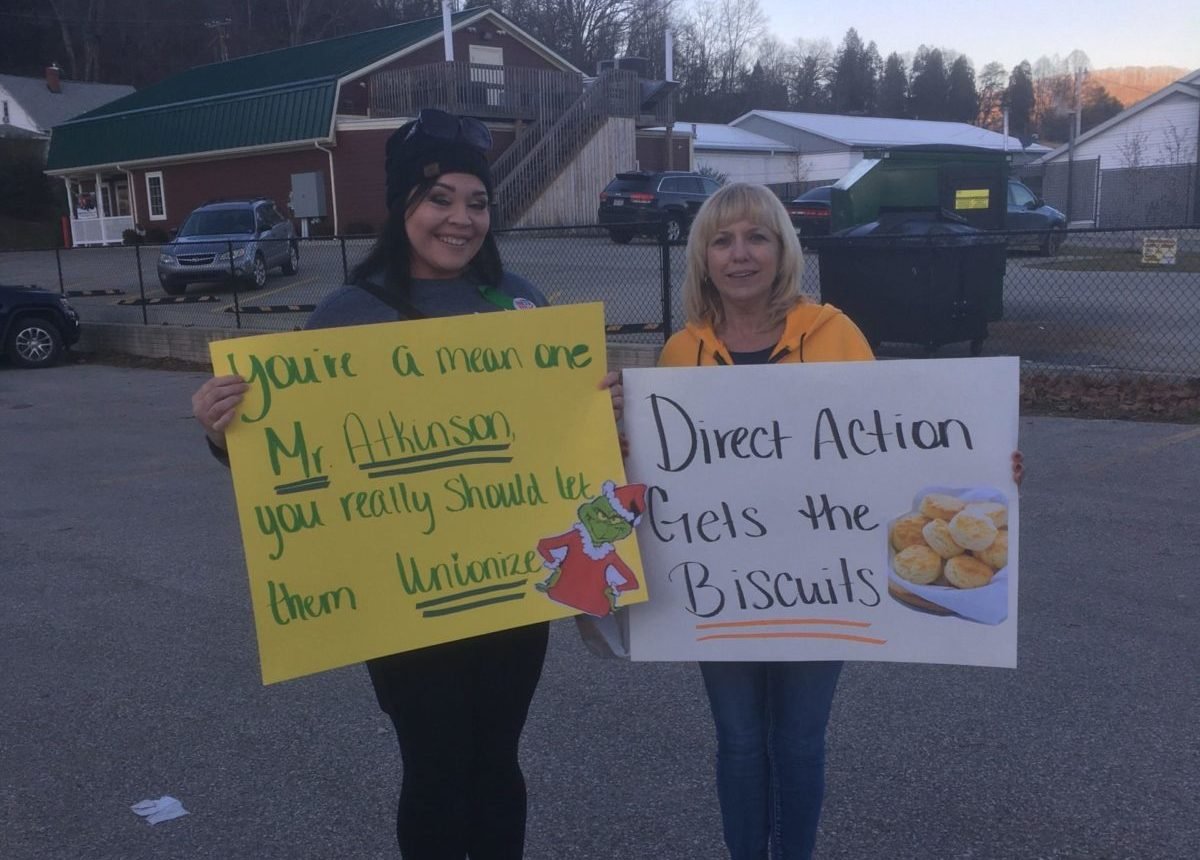WMMT’s Katie Myers tells a different kind of labor story in Appalachia
Photo by Katie Myers | Two union members stand in solidarity with the Tudor’s Biscuit World workers in Elkview.
For the past few months, Kentucky-based reporter Katie Myers has been covering labor movements in Appalachia, culminating in a three-part series focused on West Virginia. She was able to tell these stories with a fresh perspective thanks to the long stretches of time she spent living in the region, and listening off the record. She told us about how this reporting came together, and how she hopes to use what she learned in the process to tell stories in Eastern Kentucky.
Tell us who you are, and share a brief summary of the reporting project?
My name is Katie Myers and I report for a regional collaborative called the Ohio Valley ReSource. I’m based at WMMT 88.7 FM, an eastern Kentucky community radio station with a history of colorful local programming that counters stereotypes of the Appalachian coalfields and serves as a voice for mountain people.
I am working to expand the station’s strong history of local and regional reporting with a dive into labor reporting. It’s a beat that’s been generally neglected by mainstream news outlets over the past few decades and has experienced a recent resurgence. So far, I’ve been integrating these stories into WMMT’s monthly podcast, Mountain Talk, and producing features for the Ohio Valley ReSource.
Most recently, there were two strikes and two union drives happening all at once in neighboring southern West Virginia. Workers at the Special Metals alloy plant and Cabell Huntington Hospital in Huntington, WV, were both on strike. Meanwhile, regional nonprofit Ohio Valley Environmental Coalition and breakfast chain Tudor’s Biscuit World were unionizing. I wrote two long-form podcast episodes for WMMT and two shorter stories for the Ohio Valley ReSource centering these efforts over the course of November, December, and January.
How did community engagement inform your reporting?
I was conscious of the framing of other labor stories I’d recently heard. In early fall I heard a national story on NPR about the recent John Deere strike. An executive at John Deere was interviewed, as was a farmer whose livelihood had been impacted by higher tractor prices. But I never heard a worker’s voice, despite the fact that workers were driving the entire story! As a community radio reporter at a station oriented towards being a voice of mountain people, I felt a responsibility to make sure workers’ voices were always central to stories about labor.
I also felt a responsibility to broaden the conversation around what work is and looks like here in the coalfields. I’ve been in many conversations with young people in Appalachia over the years that have gone along the lines of, “I’m just as Appalachian when I work for Walmart (or anywhere else) as I would be if I was a coal miner.” But these are not the labor stories we generally hear.
The story of the coal miner is the one that often gets told in our region. While it’s important, and coal has long been the underlying economic force here, it centers a certain kind of person: often able-bodied, often white, and mostly male. Today, far more people work in healthcare, other industrial work, in retail and food service, in other sectors - including many women, queer people, disabled people, elderly and young people. I listened to these young people in my community when they said they didn’t always feel represented by the coal miner’s story, and that’s informed my thinking on it since. These were group and one-on- one unrecorded conversations, mostly held among friends and in community organizing spaces over the course of the years I’ve spent in Appalachia, many held before I became a journalist. These conversations, in fact, generated the questions that drove me towards journalism in the first place. So, I wanted to focus on Appalachian workplaces right here, right now.
How did you build trust in the community you were reporting on?
The most important thing to them was that I show up in person. Particularly for the workers at Tudor’s Biscuit World, who had been fielding ten-minute calls from national reporters all week. They were sick of having to frame the same story in the same ways over and over again, and wanted a chance to speak to the region through me, to people who were like them, working low-wage jobs in the mountains.
I went to West Virginia in person twice, for two days each. I made sure not to rush, and to speak with whoever wanted to talk to me. I think that was appreciated.
Finally, in terms of direct engagement, I also made sure to let folks speak with me off the record frequently. I called sources ahead of time to talk them through what the story was going to look like, without recording. I also did not record the entire time during my visits, instead sitting and chatting for a little bit before I turned the recorder on.
How are you bringing this reporting back to the community?
I made sure to send the reporting back to the emails I had for the contacts I had made. I informed them when it would be airing as well. I also solicited feedback, since I’m always wanting to do better!
The reporting trips also naturally led into one another, as these things tend to do. I have been keeping up with the issues by spotting updates for our station whenever possible, and continue to follow up with the people I met in the course of this reporting.
I ended each story with a call out for further labor stories to bolster our series. I also hope to follow with a survey designed to catch interested folks, which I hope to have online and in person. My station will begin tabling at public events and spaces next month as an outreach tactic as well, and we will be referring to these stories as we seek others like them. We plan to be at libraries, sports events, and festivals.
What lessons do you take away from this project in terms of strengthening your engagement?
My labor roundup of these issues with the Ohio Valley ReSource has become one of the highest-viewed on our site. It’s clear to me that labor issues have taken a new urgency in peoples’ minds, especially as the pandemic rages onward without the initial protections and financial support of early 2020, and people are hungry for more stories. For now, I’m excited to focus that energy closer to where I am in eastern Kentucky. I hope to begin on-the-ground community outreach in the springtime and solicit stories about work and workers wherever I can. As a reporter, my official beat is economic transition, so I’m interested in stories about the experience of working in the Appalachian “new economy” - in tourism, in agritech, in minelands reclamation. I’m equally interested in the stories of the workers who’ve always been here - in public schools, home health care, hospitals, retail and more. I’m excited to see who I find.


